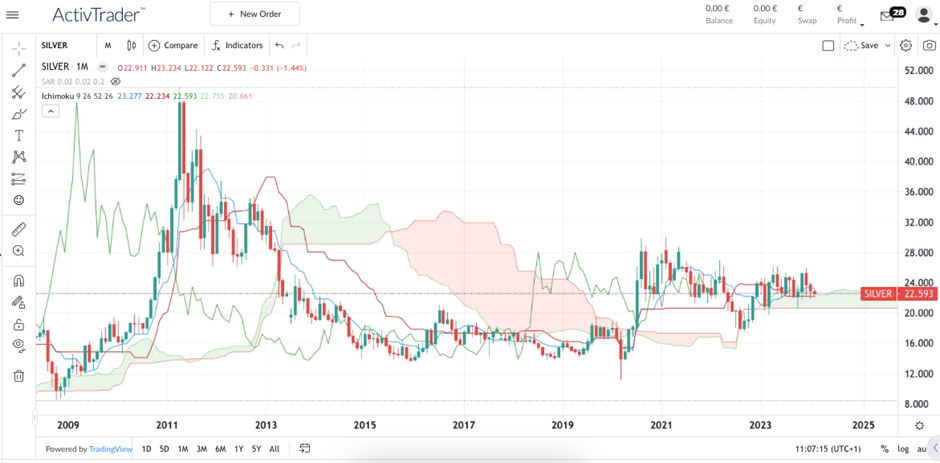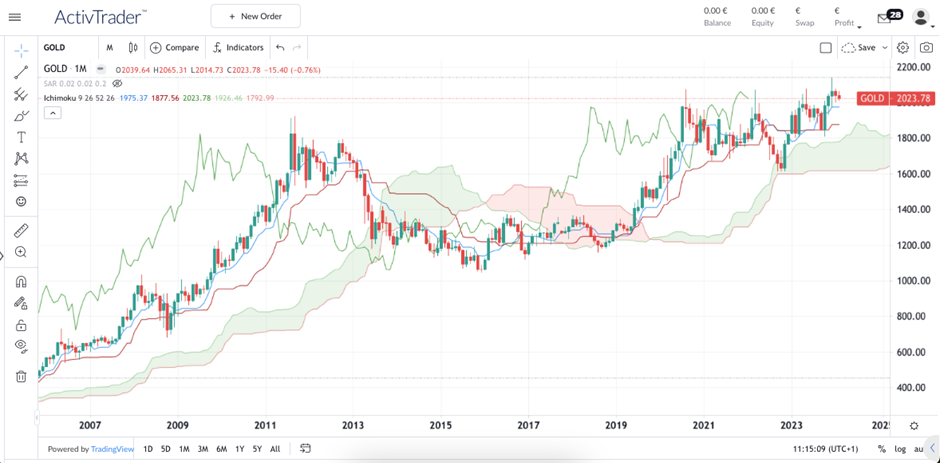If you’re considering investing in the commodity market in 2024, precious metals such as Gold and Silver should be at the top of your list of potential investments. In this article, we will discuss the factors that influence the prices of Gold and Silver, as well as the expectations that experts have for both metals and the ways in which you may profit from both markets.
Key differences between Gold and Silver you should consider before investing in either precious metal, according to Morgan Stanley
Before deciding to invest in either metal, you need to consider the factors that distinguish Gold and Silver, especially in terms of their responsiveness to economic conditions and their roles in investment portfolios as highlighted by Morgan Stanley.
Firstly, Silver tends to be more sensitive to the economic cycle than Gold, which reflects the different roles each metal plays in the economy. Silver's extensive use in industries such as electronics, electrical engineering, and green technologies makes it more closely linked to economic fluctuations, whereas Gold is primarily used in jewellery and for investment purposes. So during economic upturns, the demand for Silver typically grows at a faster rate than for Gold, especially as demand for technologies linked to renewable energy solutions continues to rise.
Then, Gold is regarded as a more effective diversification asset than Silver due to its relatively lower sensitivity to economic fluctuations. In times of economic uncertainty, Gold is often sought after as a safe haven, enhancing its appeal as a reliable store of value. Conversely, Silver's value tends to be more volatile due to its extensive usage across economically sensitive industries.
Finally, Gold is typically weakly correlated with other major asset classes, further enhancing its attractiveness for portfolio diversification. Its stability during market downturns provides investors with a hedge against volatility in other assets like equities or bonds, making it an attractive component for risk management strategies.
Which factors influence the price of Gold and Silver?
● Value of the USD
● Geopolitical conflicts
● Stage of the economic growth
● Monetary policies
● Inflation levels
● Industrial demand
● Technological progress
● Speculation
● Market sentiment
Advantages of trading Gold
● One of the most popular precious metal to trade
● High liquidity
● Great accessibility
● More powerful portfolio diversifier than Silver
● High demand from emerging markets
● Rising middle-class, which is the largest spending group worldwide
Advantages of trading Silver
● Volatility
● Cheaper than Gold and other metals
● Metal required in different sectors, which is likely to drive technology-drive demand higher
● Rise of end-uses in the green energy trend
● Emerging markets
● Liquidity
● Accessibility
👉 Read our guide on How to invest in Silver
Gold vs Silver in 2024 - What are experts saying?
According to the Silver Institute, global Silver demand is projected to reach 1.2 billion ounces this year thanks to strong economic growth and lower interest rates, which would represent the second-highest level ever recorded. For the non-profit international association, Silver prices are forecast to soar to $30 per ounce, the highest point in a decade.

Silver Monthly Chart - Source: ActivTrader platform
UBS analysts anticipate that both metals will see a surge in value due to the Federal Reserve's anticipated interest rate cuts later this year. This projection is based on expectations of a weaker US dollar and heightened attractiveness of Gold and Silver compared to other relatively safe investment options like bonds in times of lower rates. Gold prices are expected to reach $2,200 per ounce by the end of 2024, according to UBS.
According to analysts at the bank, once the Federal Reserve begins cutting interest rates, Silver is poised to outshine and surpass Gold, especially considering its recent underperformance relative to the yellow metal.

Gold Monthly Chart - Source: ActivTrader platform
👉 Read our guide on The relationship between inflation, interest rates, and bonds
How to invest in Gold and Silver in 2024
There are different ways to invest in Gold and Silver, depending on your risk profile, financial objectives, trading style, as well as investment horizon and main scenario for the commodity (up or down).
Buying physical precious metals
Owning physical precious metals like Gold or Silver is particularly advantageous for individuals with limited market understanding. Unlike investing in stocks or other financial instruments, which demands a deep understanding of market trends, corporate performance analysis, and staying abreast of economic news, physical ownership of precious metals requires less expertise.
Given that the value of Gold and Silver is primarily determined by their inherent characteristics and scarcity, these metals offer a more accessible investment avenue for those less familiar with financial markets. Moreover, physical ownership provides a tangible asset that can be easily understood and valued, regardless of their level of financial literacy. This makes it a popular choice for those seeking stability and security in their investment portfolios.
Another advantage of physically possessing Gold or Silver is that you have complete control over how and where you store the metals to ensure their safety.
Unlike investing in Gold or Silver through financial instruments, physical ownership allows you the freedom to choose the method and location of asset storage, providing peace of mind and reducing the risk of theft or loss. Furthermore, having physical possession of Gold or Silver allows for a tangible and tactile connection to your wealth. Holding a tangible asset in your hands can instil a sense of security and stability, particularly during periods of economic uncertainty. Lastly, since physical ownership facilitates wealth succession or transfer to future generations, precious metals can be passed down as a legacy.
While there are numerous benefits to physically owning Gold or Silver, it's important to consider potential drawbacks as well. Firstly, there are various expenses and risks associated with storing physical assets. Moreover, there's always the risk of theft or loss, especially if assets aren't adequately secured.
Physical possession of Gold or Silver requires careful consideration of asset liquidity. Unlike financial instruments, physical assets may not be as easily converted into cash when needed, so anybody considering physical ownership should evaluate their short-term financial needs and liquidity requirements accordingly. Investors looking for flexibility and liquidity can opt for paper Gold or Silver investments, as it offers several benefits.
Examples of buying physical Gold and Silver
● Bullion
● Coins
● Bars
● Jewellery
👉 Read our guide on Paper Gold vs Physical Gold
Trading metals over the short to medium-term
Financial instruments on Gold and Silver provide greater flexibility, as they allow investors to easily buy and sell their holdings on exchanges and through regulated brokers like ActivTrades. This means that investors can quickly react to market changes and take advantage of price fluctuations in either direction (bullish or bearish movements).
Additionally, paper Gold and Silver investments offer liquidity, as investors can convert their holdings into cash relatively easily. Also, investing in paper Gold or Silver is relatively accessible to a wide range of investors as these investments can be made through brokerage accounts and online platforms, making it convenient for individuals to participate in the market with a simple online trading account
However, one potential drawback is that investors do not directly own the physical metal, which means they do not have the same level of security as owning physical Gold or Silver. Also, the value of paper Gold and Silver investments is dependent on market conditions and can be subject to volatility and counterparty risk.
Besides, the costs associated with paper Gold and Silver investments vary depending on the specific product and provider. Some investments may have management fees, transaction costs, or other expenses that can impact the overall return on investment.
Derivatives on Gold and Silver can take various forms, including futures, options, and Contracts For Difference (CFD).
Futures contracts are agreements to buy or sell Gold and Silver at a predetermined price and date in the future, while options contracts give traders the right, but not the obligation, to buy or sell Gold and Silver at a specified price within a certain timeframe. Contracts For Difference (CFD) like those offered by ActivTrades allow traders to speculate on the price movements of Gold and Silver without owning the precious metals through a financial contract, and the difference between the opening and closing price of the contract is settled in cash.
It is also possible to use Exchange Traded Funds (ETF) or Exchange Traded Products (ETP) on Gold and Silver, as they provide a convenient and cost-effective way to gain exposure to the Gold and Silver market without having to directly buy or store physical Gold.
While derivatives offer an alternative way to speculate on Gold and Silver prices without owning the physical metal, they come with their own set of risks and limitations.
Firstly, derivatives can be complex financial instruments that may require a certain level of knowledge and expertise to navigate effectively. They are not for every type of trader and investor. Additionally, derivatives can be subject to leverage, meaning that investors can potentially amplify their gains or losses. This can result in significant financial risk, especially for inexperienced investors, and may incur losses.
Examples of trading derivatives on Gold and Silver
● XAU/EUR CFD
● XAU/GBP CFD
● XAU/USD CFD
● Call Gold or Silver options through the COMEX
● Put Gold or Silver options through the COMEX
● iShares Silver Trust ETF
● Goldman Sachs Physical Gold ETF
👉 Read our guide on Top 4 scalping strategies
Buying shares of publicly traded mining companies
If you're considering an alternative indirect approach to investing in Gold and Silver, you might explore investing in publicly traded mining companies. By purchasing shares in firms engaged in Gold and Silver production, investors gain exposure to the potential profits generated by these activities.
The stock price of a mining company could experience significant growth if the company successfully increases output or discovers new high quality mines. Additionally, the value of mining stocks may rise with increased demand for Gold and Silver, driven by factors such as technological needs and concerns about inflation and economic instability. Mining companies can also offer dividends to shareholders, providing not only the potential for financial gains but also a regular income stream.
However, investing in mining stocks also carries risks like operational hazards, management decisions, and geopolitical changes.
Operational risks such as accidents, equipment failures, labor disputes, and environmental regulations can disrupt production, increase expenses, and damage the company's reputation, potentially impacting the stock price. Moreover, management decisions regarding resource allocation, exploration initiatives, and production goals can significantly affect mining stocks. Finally, geopolitical events such as changes in mining regulations, trade policies, and political instability in key mining regions can introduce volatility and uncertainty into the market.
Examples of buying mining shares
● Polymetal International
● Fresnillo
● Newmont
● Barrick Gold
● Newcrest Mining
👉 Read our guide on How to get started with dividend investing
The information provided does not constitute investment research. The material has not been prepared in accordance with the legal requirements designed to promote the independence of investment research and as such is to be considered to be a marketing communication.
All information has been prepared by ActivTrades (“AT”). The information does not contain a record of AT’s prices, or an offer of or solicitation for a transaction in any financial instrument. No representation or warranty is given as to the accuracy or completeness of this information.
Any material provided does not have regard to the specific investment objective and financial situation of any person who may receive it. Past performance is not a reliable indicator of future performance. AT provides an execution-only service. Consequently, any person acting on the information provided does so at their own risk.